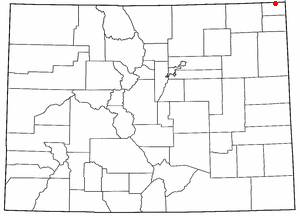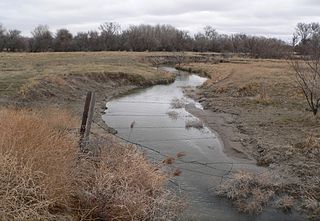
The Arapaho are a Native American people historically living on the plains of Colorado and Wyoming. They were close allies of the Cheyenne tribe and loosely aligned with the Lakota and Dakota.

The Cheyenne are an Indigenous people of the Great Plains. Their Cheyenne language belongs to the Algonquian language family. Today, the Cheyenne people are split into two federally recognized nations: the Southern Cheyenne, who are enrolled in the Cheyenne and Arapaho Tribes in Oklahoma, and the Northern Cheyenne, who are enrolled in the Northern Cheyenne Tribe of the Northern Cheyenne Indian Reservation in Montana.

The Sand Creek massacre was a massacre of Cheyenne and Arapaho people by the U.S. Army in the American Indian Wars that occurred on November 29, 1864, when a 675-man force of the Third Colorado Cavalry under the command of U.S. Volunteers Colonel John Chivington attacked and destroyed a village of Cheyenne and Arapaho people in southeastern Colorado Territory, killing and mutilating an estimated 69 to over 600 Native American people. Chivington claimed 500 to 600 warriors were killed. However, most sources estimate around 150 people were killed, about two-thirds of whom were women and children. The location has been designated the Sand Creek Massacre National Historic Site and is administered by the National Park Service. The massacre is considered part of a series of events known as the Colorado Wars.

The Wounded Knee Massacre, also known as the Battle of Wounded Knee, was the deadliest mass shooting in American history, involving nearly three hundred Lakota people shot and killed by soldiers of the United States Army. The massacre, part of what the U.S. military called the Pine Ridge Campaign, occurred on December 29, 1890, near Wounded Knee Creek on the Lakota Pine Ridge Indian Reservation in South Dakota, following a botched attempt to disarm the Lakota camp. The previous day, a detachment of the U.S. 7th Cavalry Regiment commanded by Major Samuel M. Whitside approached Spotted Elk's band of Miniconjou Lakota and 38 Hunkpapa Lakota near Porcupine Butte and escorted them five miles westward to Wounded Knee Creek, where they made camp. The remainder of the 7th Cavalry Regiment, led by Colonel James W. Forsyth, arrived and surrounded the encampment. The regiment was supported by a battery of four Hotchkiss mountain guns. The Army was catering to the anxiety of settlers who called the conflict the Messiah War and were worried the Ghost Dance signified a potentially dangerous Sioux resurgence. Historian Jeffrey Ostler wrote in 2004, "Wounded Knee was not made up of a series of discrete unconnected events. Instead, from the disarming to the burial of the dead, it consisted of a series of acts held together by an underlying logic of racist domination."

Red Cloud was a leader of the Oglala Lakota from 1865 to 1909. He was one of the most capable Native American opponents whom the United States Army faced in the western territories. He led the Lakota to defeat the United States during Red Cloud's War, establishing the Lakota as the only nation besides the British to defeat the United States on American soil. The largest action of the war was the 1866 Fetterman Fight, with 81 US soldiers killed; it was the worst military defeat suffered by the US Army on the Great Plains until the Battle of the Little Bighorn 10 years later.

Red Cloud's War was an armed conflict between an alliance of the Lakota, Northern Cheyenne, and Northern Arapaho peoples against the United States and the Crow Nation that took place in the Wyoming and Montana territories from 1866 to 1868. The war was fought over control of the western Powder River Country in present north-central Wyoming.

The Grattan Massacre, also known as the Grattan Fight, was the opening engagement of the First Sioux War, fought between the United States Army and Lakota Sioux warriors on August 19, 1854. It occurred east of Fort Laramie, Nebraska Territory, in present-day Goshen County, Wyoming.

Fort Caspar was a military post of the United States Army in present-day Wyoming, named after 2nd Lieutenant Caspar Collins, a U.S. Army officer who was killed in the 1865 Battle of the Platte Bridge Station against the Lakota and Cheyenne. Founded in 1859 along the banks of the North Platte River as a trading post and toll bridge on the Oregon Trail, the post was later taken over by the Army and named Platte Bridge Station to protect emigrants and the telegraph line against raids from Lakota and Cheyenne in the ongoing wars between those nations and the United States. The site of the fort, near the intersection of 13th Street and Wyoming Boulevard in Casper, Wyoming, is listed in the National Register of Historic Places and is now owned and operated by the City of Casper as the Fort Caspar Museum and Historic Site.

The Sioux Wars were a series of conflicts between the United States and various subgroups of the Sioux people which occurred in the later half of the 19th century. The earliest conflict came in 1854 when a fight broke out at Fort Laramie in Wyoming, when Sioux warriors killed 31 American soldiers in the Grattan Massacre, and the final came in 1890 during the Ghost Dance War.

The Powder River Expedition of 1865 also known as the Powder River War or Powder River Invasion, was a large and far-flung military operation of the United States Army against the Lakota Sioux, Cheyenne, and Arapaho Indians in Montana Territory and Dakota Territory. Although soldiers destroyed one Arapaho village and established Fort Connor to protect gold miners on the Bozeman Trail, the expedition is considered a failure because it failed to defeat or intimidate the Indians.

The Colorado War was an Indian War fought in 1864 and 1865 between the Southern Cheyenne, Arapaho, and allied Brulé and Oglala Sioux peoples versus the U.S. Army, Colorado militia, and white settlers in Colorado Territory and adjacent regions. The Kiowa and the Comanche played a minor role in actions that occurred in the southern part of the Territory along the Arkansas River. The Cheyenne, Arapaho, and Sioux played the major role in actions that occurred north of the Arkansas River and along the South Platte River, the Great Platte River Road, and the eastern portion of the Overland Trail. The United States government and Colorado Territory authorities participated through the 1st Colorado Cavalry Regiment, often called the Colorado volunteers. The war was centered on the Colorado Eastern Plains, extending eastward into Kansas and Nebraska.

Spotted Tail was a Sichangu Lakota tribal chief. Famed as a great warrior since his youth, warring on Ute, Pawnee and Absaroke (“Crow”), and having taken a leading part in the Grattan Massacre, he led his warriors in the Colorado and Platte River uprising after the massacre performed by John M. Chivington's Colorado Volunteers of the peaceful Cheyenne and Arapaho camping on Sand Creek, but declined to participate in Red Cloud's War.

Tasunka Kokipapi, was an Oglala Lakota leader known for his participation in Red Cloud's War, as a negotiator for the Sioux Nation after the Wounded Knee Massacre, and for serving on delegations to Washington, D.C.. During and after his lifetime American sources and written records mistranslated his name as Young Man Afraid of His Horses or uncommonly as His-Horses-Are-Afraid, but a proper translation is They-Fear-Even-His-Horses or His Horse Is Feared, meaning that the bearer of the name was so feared in battle that even the sight of his horse would inspire fear.

The Battle of Julesburg took place on January 7, 1865, near Julesburg, Colorado between 1,000 Cheyenne, Arapaho, and Lakota Indians and about 60 soldiers of the U.S. army and 40 to 50 civilians. The Indians defeated the soldiers and over the next few weeks plundered ranches and stagecoach stations up and down the South Platte River valley.

The Battle of Rush Creek took place February 8–9, 1865, between about 185 soldiers of the U.S. Army and 1,000 warriors of the Lakota Sioux, Cheyenne, and Arapaho tribes. It was part of a series of retaliations by the Native American alliance after the U.S. army committed the Sand Creek Massacre. The inconclusive battle took place 4 mi southeast of present-day Broadwater, Nebraska, along both banks of the North Platte River.
The Battle of Platte Bridge, also called the Battle of Platte Bridge Station, on July 26, 1865, was the culmination of a summer offensive by the Lakota Sioux and Cheyenne Indians against the United States army. In May and June the Indians raided army outposts and stagecoach stations over a wide swath of Wyoming and Montana. In July, they assembled a large army, estimated by Cheyenne warrior George Bent to number 3,000 warriors, and descended upon Platte Bridge. The bridge, across the North Platte River near present-day Casper, Wyoming, was guarded by 120 soldiers. In an engagement near the bridge, and another against a wagon train guarded by 28 soldiers a few miles away, the Indians killed 29 soldiers while suffering at least eight dead.

South Platte Trail was a historic trail that followed the southern side of South Platte River from Fort Kearny in Nebraska to Denver, Colorado. Plains Indians, such as the Cheyenne and the Arapaho, hunted in the lands around the South Platte River. They also traded at trading posts along the route, as did white travelers. Travelers included trappers, traders, explorers, the military, and those following the gold rush. The trail was also used by the Pony Express.
The Big Horn Expedition, or Bighorn Expedition, was a military operation of the United States Army against the Lakota Sioux and Cheyenne Indians in Wyoming Territory and Montana Territory. Although soldiers destroyed one Northern Cheyenne and Oglala Lakota village at the Battle of Powder River, the expedition solidified Lakota Sioux and Northern Cheyenne resistance against the United States attempt to force them to sell the Black Hills and live on a reservation, beginning the Great Sioux War of 1876.
The Raid on Godfrey Ranch, also known as Skirmish with Indians at Godfrey's Ranch, occurred from January 15–16, 1865 in which a large band of Lakota and Cheyenne warriors attacked an isolated ranch in Colorado owned by Holon Godfrey. The raid was one of the numerous January raids committed by the Cheyenne and their Indian allies as retaliation for the Sand Creek massacre that happened on November 29, 1864 during the Colorado War. After their victory at the Battle of Julesburg, the Indians raided up and down the South Platte River valley. Among the ranches the Indians attacked was the American Ranch, in which a white family and some of their workers perished before the Cheyenne set their sights on Godfrey's ranch nearby. Godfrey learned of the Indians' upcoming attack and fortified his ranch together with his family and ranch hands. At night, Godfrey estimated that 130 Indian warriors surrounded and attacked his ranch. The men inside managed to hold off them off the whole night. By morning, one of Godfrey's men managed to sneak out of the siege and call for help from the U.S. cavalry, which forced the Indians to finally retreat. The ranch, though burned and having lost some of its horses, remained standing and Godfrey's stand was successful. Godfrey christened his ranch as Fort Wicked.

Fort Wicked was a ranch and stage station on the Overland Trail from 1864 to 1868 in present-day Merino, Colorado. A historical marker commemorating the ranch is located at US 6 and CR-2.5. The ranch itself was located near a ford of the South Platte River, near where US-6 now crosses over the river. Fort Wicked was one of the few places along the trail to Denver that withstood an attack by Lakota, Cheyenne, and Arapaho Native Americans in the Colorado War of 1864. It was named Fort Wicked for the "bitter defence" made by Holon Godfrey, his family, and his employees.
















